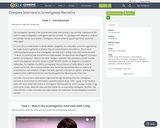
- Subject:
- Social Work
- Material Type:
- Module
- Author:
- Tim Wohltmann
- Date Added:
- 08/24/2016

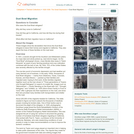
In 1931, a severe drought hit the Southern and Midwestern plains. As crops died and winds picked up, dust storms began. As the "Dust Bowl" photograph shows, crops literally blew away in "black blizzards" as years of poor farming practices and over-cultivation combined with the lack of rain. By 1934, 75% of the United States was severely affected by this terrible drought.The one-two punch of economic depression and bad weather put many farmers out of business. In the early 1930s, thousands of Dust Bowl refugees ? mainly from Oklahoma, Texas, Colorado, Kansas, and New Mexico ? packed up their families and migrated west, hoping to find work. Entire families migrated together (such as the men shown in "Three generations of Texans now Drought Refugees") in search of a better life. Images such as "Midcontinent ? Family Standing on the Road with Car," "Drought Refugees," and "Untitled, ca. 1935 (Worn-Down Family in Front of Tent)" offer a glimpse into their experience on the road, and show that cars provided many families both transportation and shelter on the road. About 200,000 of the migrants headed for California. The state needed to figure out how to absorb the thousands of destitute people crossing its borders daily. One of their tactics was to document the plight of the refugees. In 1935, photographer Dorothea Lange joined the Rural Rehabilitation Division of the California State Emergency Relief Administration (SERA), a section of the Federal Emergency Relief Administration. She was assigned the job of using her camera to document the growing number of homeless Dust Bowl refugees migrating to California. She worked with Paul S. Taylor, a professor at the University of California, Berkeley, who was researching conditions of rural poverty in order to make recommendations on how to improve the workers' conditions. The work by Taylor and Lange played an important role in helping to raise public awareness of the crisis. The reports they made for the government included both data and striking images that revealed the desperate conditions in which the migrants lived and confirmed the need for government intervention. Stark images such as "Home of Oklahoma Drought Refugees" resonated with the public, and portraits of drought refugees like "Ruby from Arkansas" and others shown in this topic humanized the migrants for more fortunate citizens. In March 1936, Lange took what became one of her most famous images, "Migrant Mother." This image of a 32-year-old woman became an icon for the suffering of ordinary people during Great Depression.
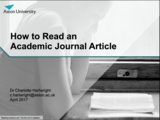
What is this resource?
This resource contains a 50-minute podcast and accompanying materials to support students and academics with reading academic journal articles, with a focus on Open Science tools in publishing. The podcast outlines a 6 stage process that can be used with any journal article from any discipline. The podcast can be downloaded as an MP4. A PDF of the podcast, which includes active links to relevant sources on the web, is also available. In addition, there is a blank journal scrapbook which can be used to record reading.
Who will find this resource helpful?
If you find it difficult to read journal articles because you get lost, or forget your purpose, or if you have no reading purpose (for example, you've been told to read it for your studies), this guide will help you take a structured approach.
Podcast Topics Covered
Part1: Background Introduction (~20 minutes duration)
• What is a journal article
• The publication process
• Different types of journal article
• (Open Science) Badges
• CrossMark
• Journal Metrics
Part 2: Preparing to read a journal article (from ~19 minutes in)
• Tool kit
• Reading goals
Direct links:
Podcast: https://osf.io/gfj9q/
Accompanying slides: https://osf.io/7r3kn/
Journal Scrapbook (for users to complete): https://osf.io/eqjfh/
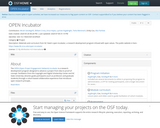
The OPEN (Open Project Engagement Network) Incubator is a research development program and modular curriculum designed to advance a project from idea to proof-of-concept, infused with and aware of open scholarship principles and practices.
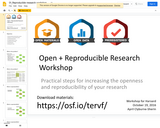
Topics covered:
Understanding reproducible research
Setting up a reproducible project
Understanding power
Preregistering your study
Keeping track of things
Containing bias
Sharing your work
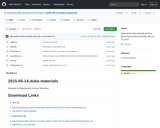
Workshop goals
- Why are we teaching this
- Why is this important
- For future and current you
- For research as a whole
- Lack of reproducibility in research is a real problem
Materials and how we'll use them
- Workshop landing page, with
- links to the Materials
- schedule
Structure oriented along the Four Facets of Reproducibility:
- Documentation
- Organization
- Automation
- Dissemination
Will be available after the Workshop
How this workshop is run
- This is a Carpentries Workshop
- that means friendly learning environment
- Code of Conduct
- active learning
- work with the people next to you
- ask for help

The transition from high school and home to college and a new living environment can be a fascinating and interesting time, made all the more challenging and interesting by being at MIT. More than recording the first semester through a series of snapshots, this freshman seminar will attempt to teach photography as a method of seeing and a tool for better understanding new surroundings. Over the course of the semester, students will develop a body of work through a series of assignments, and then attempt to describe the conditions and emotions of their new environment in a cohesive final presentation.

Nigel Poor is a photographer who spends time documenting everyday existence, exploring the meaning of the traces of ourselves that we leave behind. She focuses on ordinary objects and materials, researching what makes an object “worthy of preservation,” in her words. This KQED Art School video was created in collaboration with SFMOMA, who commissioned art-making activity ideas from Nigel Poor for their Open Studio project.
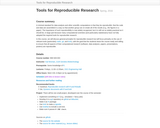
Course summary
A minimal standard for data analysis and other scientific computations is that they be reproducible: that the code and data are assembled in a way so that another group can re-create all of the results (e.g., the figures in a paper). The importance of such reproducibility is now widely recognized, but it is still not so widely practiced as it should be, in large part because many computational scientists (and particularly statisticians) have not fully adopted the required tools for reproducible research.
In this course, we will discuss general principles for reproducible research but will focus primarily on the use of relevant tools (particularly make, git, and knitr), with the goal that the students leave the course ready and willing to ensure that all aspects of their computational research (software, data analyses, papers, presentations, posters) are reproducible.
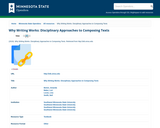
Why Writing Works: Disciplinary Approaches to Composing Texts is an open-access, online textbook resource for college writing. It is written for an audience of second-year college students with a focus on writing in the disciplines.
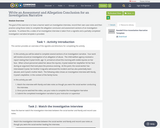
The goal of this exercise is to have a learner watch an investigative interview, record their own case notes and then practice using those notes to complete the allegation conclusion and assessment sections of an investigation narrative. To achieve this, a video of an investigative interview is taken from a vignette and a partially completed investigation narrative template is provided.